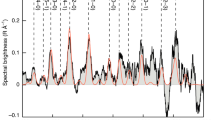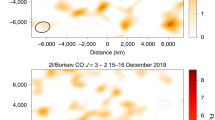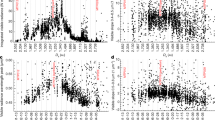Abstract
The interstellar traveller, 2I/Borisov, is the first clearly active extrasolar comet ever detected in our Solar System. We obtained high-resolution interferometric observations of 2I/Borisov with the Atacama Large Millimeter/submillimeter Array (ALMA) and multi-colour optical observations with the Very Large Telescope (VLT) to gain a comprehensive understanding of the dust properties of this comet. We found that the dust coma of 2I/Borisov consists of compact ‘pebbles’ of radii exceeding ~1 mm, suggesting that the dust particles have experienced compaction through mutual impacts during the bouncing collision phase in the protoplanetary disk. We derived a dust mass-loss rate of ≳200 kg s−1 and a dust-to-gas ratio ≳3. Our long-term monitoring of 2I/Borisov with the VLT indicates a steady dust mass-loss with no significant dust fragmentation and/or sublimation occurring in the coma. We also detected emissions from carbon monoxide (CO) gas with ALMA and derived the gas production rate of Q(CO) = (3.3 ± 0.8) × 1026 s−1. We found that the CO/H2O mixing ratio of 2I/Borisov changed drastically before and after perihelion, indicating the heterogeneity of the cometary nucleus, with components formed at different locations beyond the volatile snow-line with different chemical abundances. Our observations suggest that 2I/Borisov’s home system, much like our own system, experienced efficient radial mixing from the innermost parts of its protoplanetary disk to beyond the frost line of CO.
This is a preview of subscription content, access via your institution
Access options
Access Nature and 54 other Nature Portfolio journals
Get Nature+, our best-value online-access subscription
$29.99 / 30 days
cancel any time
Subscribe to this journal
Receive 12 digital issues and online access to articles
$119.00 per year
only $9.92 per issue
Buy this article
- Purchase on Springer Link
- Instant access to full article PDF
Prices may be subject to local taxes which are calculated during checkout




Similar content being viewed by others
Data availability
This work makes use of ALMA dataset ADS/JAO.ALMA#2019.A.00002.S, which is available for download from the ALMA Science Archive (http://almascience.nrao.edu/aq/) following a 9-month proprietary period. The VLT dataset is available for download from the ESO Science Archive (http://archive.eso.org/eso/eso_archive_main.html), under ESO program ID 2103.C-5068 and 0105.C-0250, principal investigator O.R.H., following a 1-year proprietary period.
Change history
19 April 2021
A Correction to this paper has been published: https://doi.org/10.1038/s41550-021-01367-3
References
Charnoz, S. & Morbidelli, A. Coupling dynamical and collisional evolution of small bodies: an application to the early ejection of planetesimals from the Jupiter-Saturn region. Icarus 166, 141–156 (2003).
Meech, K. J. et al. A brief visit from a red and extremely elongated interstellar asteroid. Nature 552, 378–381 (2017).
The ‘Oumuamua ISSI Team The natural history of ‘Oumuamua. Nat. Astron. 3, 594–602 (2019).
Guzik, P. et al. Initial characterization of interstellar comet 2I/Borisov. Nat. Astron. 4, 53–57 (2020).
Fitzsimmons, A. et al. Detection of CN gas in interstellar object 2I/Borisov. Astrophys. J. Lett. 885, L9 (2019).
Opitom, C. et al. 2I/Borisov: a C2-depleted interstellar comet. Astron. Astrophys. 631, L8 (2019).
Bodewits, D. et al. The carbon monoxide-rich interstellar comet 2I/Borisov. Nat. Astron. 4, 867–871 (2020).
Cordiner, M. A. et al. Unusually high CO abundance of the first active interstellar comet. Nat. Astron. 4, 861–866 (2020).
Jewitt, D. et al. The nucleus of interstellar comet 2I/Borisov. Astrophys. J. Lett. 888, L23 (2020).
Hui, M.-T., Ye, Q.-Z., Föhring, D., Hung, D. & Tholen, D. J. Physical characterization of interstellar comet 2I/2019 Q4 (Borisov). Astron. J. 160, 92 (2020).
Cochran, A. L. et al. The composition of comets. Space Sci. Rev. 197, 9–46 (2015).
Fray, N. et al. Nitrogen-to-carbon atomic ratio measured by COSIMA in the particles of comet 67P/Churyumov-Gerasimenko. Mon. Not. R. Astron. Soc. 469, S506–S516 (2017).
Levasseur-Regourd, A.-C. et al. Cometary dust. Space Sci. Rev. 214, 64 (2018).
A’Hearn, M. F. Comets: looking ahead. Philos. Trans. R. Soc. Lond. Ser. A 375, 20160261 (2017).
Davidsson, B. J. R. et al. The primordial nucleus of comet 67P/Churyumov-Gerasimenko. Astron. Astrophys. 592, A63 (2016).
Fulle, M. The ice content of Kuiper belt objects. Nat. Astron. 1, 0018 (2017).
Güttler, C. et al. Synthesis of the morphological description of cometary dust at comet 67P/Churyumov-Gerasimenko. Astron. Astrophys. 630, A24 (2019).
Li, A. & Greenberg, J. M. From interstellar dust to comets: infrared emission from comet Hale-Bopp (C/1995 O1). Astrophys. J. Lett. 498, L83–L87 (1998).
Wentworth, C. K. A scale of grade and class terms for clastic sediments. J. Geol. 30, 377–392 (1922).
Johansen, A. & Lambrechts, M. Forming planets via pebble accretion. Annu. Rev. Earth Planet. Sci. 45, 359–387 (2017).
Jewitt, D. & Matthews, H. Particulate mass loss from comet Hale-Bopp. Astron. J. 117, 1056–1062 (1999).
Bohren, C. F. & Huffman, D. R. Absorption and Scattering of Light by Small Particles (Wiley, 1983).
Divine, N. et al. The comet Halley dust and gas environment. Space Sci. Rev. 43, 1–104 (1986).
Ye, Q. et al. Pre-discovery activity of new interstellar comet 2I/Borisov beyond 5 au. Astron. J. 159, 77 (2020).
Jewitt, D. & Luu, J. Initial characterization of interstellar comet 2I/2019 Q4 (Borisov). Astrophys. J. Lett. 886, L29 (2019).
Cremonese, G. et al. Dust environment model of the interstellar comet 2I/Borisov. Astrophys. J. Lett. 893, L12 (2020).
Kim, Y. et al. Coma anisotropy and the rotation pole of interstellar comet 2I/Borisov. Astrophys. J. Lett. 895, L34 (2020).
Pätzold, M. et al. The nucleus of comet 67P/Churyumov-Gerasimenko—Part I: the global view—nucleus mass, mass-loss, porosity, and implications. Mon. Not. R. Astron. Soc. 483, 2337–2346 (2019).
Bolin, B. T. et al. Characterization of the nucleus, morphology, and activity of interstellar comet 2I/Borisov by optical and near-infrared GROWTH, Apache Point, IRTF, ZTF, and Keck observations. Astron. J. 160, 26 (2020).
Kolokolova, L., Jockers, K., Chernova, G. & Kiselev, N. Properties of cometary dust from color and polarization. Icarus 126, 351–361 (1997).
Yang, B. et al. Searching for water ice in the coma of interstellar object 2I/Borisov. Astron. Astrophys. 634, L6 (2020).
Xing, Z., Bodewits, D., Noonan, J. & Bannister, M. T. Water production rates and activity of interstellar comet 2I/Borisov. Astrophys. J. Lett. 893, L48 (2020).
Läuter, M., Kramer, T., Rubin, M. & Altwegg, K. Surface localization of gas sources on comet 67P/Churyumov-Gerasimenko based on DFMS/COPS data. Mon. Not. R. Astron. Soc. 483, 852–861 (2019).
Rotundi, A. et al. Dust measurements in the coma of comet 67P/Churyumov-Gerasimenko inbound to the Sun. Science 347, aaa3905 (2015).
Choukroun, M. et al. Dust-to-gas and refractory-to-ice mass ratios of comet 67P/Churyumov-Gerasimenko from Rosetta observations. Space Sci. Rev. 216, 44 (2020).
Singh, P. D., de Almeida, A. A. & Huebner, W. F. Dust release rates and dust-to-gas mass ratios of eight comets. Astron. J. 104, 848 (1992).
Lamy, P. L., Toth, I., Weaver, H. A., A’Hearn, M. F. & Jorda, L. Properties of the nuclei and comae of 13 ecliptic comets from Hubble Space Telescope snapshot observations. Astron. Astrophys. 508, 1045–1056 (2009).
Lorek, S., Gundlach, B., Lacerda, P. & Blum, J. Comet formation in collapsing pebble clouds. What cometary bulk density implies for the cloud mass and dust-to-ice ratio. Astron. Astrophys. 587, A128 (2016).
Mannel, T. et al. Dust of comet 67P/Churyumov-Gerasimenko collected by Rosetta/MIDAS: classification and extension to the nanometer scale. Astron. Astrophys. 630, A26 (2019).
Weidenschilling, S. J. Aerodynamics of solid bodies in the solar nebula. Mon. Not. R. Astron. Soc. 180, 57–70 (1977).
Zsom, A., Ormel, C. W., Güttler, C., Blum, J. & Dullemond, C. P. The outcome of protoplanetary dust growth: pebbles, boulders, or planetesimals? II. Introducing the bouncing barrier. Astron. Astrophys. 513, A57 (2010).
Mukai, T. & Fechtig, H. Packing effect of fluffy particles. Planet. Space Sci. 31, 655–658 (1983).
Feaga, L. M. et al. Uncorrelated volatile behavior during the 2011 apparition of comet C/2009 P1 Garradd. Astron. J. 147, 24 (2014).
Cooper, J. F., Christian, E. R., Richardson, J. D. & Wang, C. Proton irradiation of Centaur, Kuiper Belt, and Oort Cloud objects at plasma to cosmic ray energy. Earth Moon Planets 92, 261–277 (2003).
Garrod, R. T. Simulations of ice chemistry in cometary nuclei. Astrophys. J. 884, 69 (2019).
Jehin, E. et al. Monitoring of the optical spectrum of comet 2I/Borisov at the VLT. In European Planetary Science Congress EPSC2020-653 (Europlanet Science Conference, 2020).
Bolin, B. T. & Lisse, C. M. Constraints on the spin-pole orientation, jet morphology, and rotation of interstellar comet 2I/Borisov with deep HST imaging. Mon. Not. R. Astron. Soc. 497, 4031–4041 (2020).
Walsh, K. J., Morbidelli, A., Raymond, S. N., O’Brien, D. P. & Mandell, A. M. A low mass for Mars from Jupiter’s early gas-driven migration. Nature 475, 206–209 (2011).
Batalha, N. M. Exploring exoplanet populations with NASA’s Kepler Mission. Proc. Natl Acad. Sci. USA 111, 12647–12654 (2014).
Kolokolova, L., Hanner, M. S., Levasseur-Regourd, A. C. & Gustafson, B. Å. S. in Comets II 577–604 (Univ. Arizona Press, 2004).
Kimura, H., Kolokolova, L., Li, A. & Lebreton, J. in Light Scattering Reviews 363–418 (Springer, 2016).
Draine, B. T. & Lee, H. M. Optical properties of interstellar graphite and silicate grains. Astrophys. J. 285, 89–108 (1984).
Li, A. & Greenberg, J. M. A unified model of interstellar dust. Astron. Astrophys. 323, 566–584 (1997).
Bardyn, A. et al. Carbon-rich dust in comet 67P/Churyumov-Gerasimenko measured by COSIMA/Rosetta. Mon. Not. R. Astron. Soc. 469, S712–S722 (2017).
Jessberger, E. K., Christoforidis, A. & Kissel, J. Aspects of the major element composition of Halley’s dust. Nature 332, 691–695 (1988).
Li, A. & Lunine, J. I. Modeling the infrared emission from the HD 141569A disk. Astrophys. J. 594, 987–1010 (2003).
Lasue, J., Levasseur-Regourd, A. C., Hadamcik, E. & Alcouffe, G. Cometary dust properties retrieved from polarization observations: application to C/1995 O1 Hale Bopp and 1P/Halley. Icarus 199, 129–144 (2009).
Draine, B. T. & Flatau, P. J. Discrete-dipole approximation for scattering calculations. J. Opt. Soc. Am. A 11, 1491–1499 (1994).
Hainaut, O. R. et al. Disintegration of active asteroid P/2016 G1 (PANSTARRS). Astron. Astrophys. 628, A48 (2019).
Tonry, J. L. et al. The Pan-STARRS1 photometric system. Astrophys. J. 750, 99 (2012).
A’Hearn, M. F., Schleicher, D. G., Millis, R. L., Feldman, P. D. & Thompson, D. T. Comet Bowell 1980b. Astron. J. 89, 579–591 (1984).
Hainaut, O. R., Boehnhardt, H. & Protopapa, S. Colours of minor bodies in the outer solar system. II. A statistical analysis revisited. Astron. Astrophys. 546, A115 (2012).
Acknowledgements
We thank P.-Y. Hsieh and C.-T. Yang for help with the ALMA data, and Z. Wahhaj, D. Jewitt and X.-J. Yang for their constructive comments. This paper makes use of the following ALMA data: ADS/JAO.ALMA#2019.A.00002.S. ALMA is a partnership of ESO (representing its member states), NSF (USA) and NINS (Japan), together with NRC (Canada), MOST and ASIAA (Taiwan), and KASI (Republic of Korea), in cooperation with the Republic of Chile. The Joint ALMA Observatory is operated by ESO, AUI/NRAO and NAOJ. This work is based on observations collected at the European Organisation for Astronomical Research in the Southern Hemisphere under ESO program 105.205Q.001. A.L. was supported in part by the National Science Foundation (under grant no. AST-1816411) and by NASA (under grants HST-AR-15037.001-A and Chandra TM9-20009X). M.A.C. was supported by the National Science Foundation (under grant no. AST-1614471) and the NASA Planetary Science Division Internal Scientist Funding Program through the Fundamental Laboratory Research work package (FLaRe). K.J.M. and J.V.K. were supported by NASA (grant no. 80NSSC18K0853).
Author information
Authors and Affiliations
Contributions
B.Y. led the application and organization of the ALMA observations and led the writing of this paper. A.L. performed dust modelling of the ALMA data and participated in the writing of this paper and the ALMA proposal. O.R.H. analysed the FORS data and M.A.C. analysed the CO data. C.-S.C. assisted in writing the ALMA proposal and reduced the ALMA data. J.P.W. contributed to ALMA observation design and data interpretation. K.J.M., J.V.K. and E.V. were co-investigators on the telescope proposals and commented on the manuscript.
Corresponding author
Ethics declarations
Competing interests
The authors declare no competing interests.
Additional information
Peer review information Nature Astronomy thanks Bryce Bolin, Anny-Chantal Levasseur-Regourd and the other, anonymous, reviewer(s) for their contribution to the peer review of this work.
Publisher’s note Springer Nature remains neutral with regard to jurisdictional claims in published maps and institutional affiliations.
Supplementary information
Supplementary Information
Supplementary Tables 1–2.
Supplementary Data
Machine-readable versions of Supplementary Tables 1 and 2.
Rights and permissions
About this article
Cite this article
Yang, B., Li, A., Cordiner, M.A. et al. Compact pebbles and the evolution of volatiles in the interstellar comet 2I/Borisov. Nat Astron 5, 586–593 (2021). https://doi.org/10.1038/s41550-021-01336-w
Received:
Accepted:
Published:
Issue Date:
DOI: https://doi.org/10.1038/s41550-021-01336-w
This article is cited by
-
Reply to: Accelerating ‘Oumuamua with H2 is challenging
Nature (2023)



